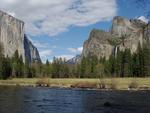Tsunami Causes Little Damage To Parks
The 8.9 earthquake that struck Japan last Friday - the fifth largest quake in the world since 1900 and nearly 8,000 times stronger than the one that recently devastated Christchurch, New Zealand - produced a tsunami that crossed the Pacific and came up on the shores of park beaches from Guam to the West Coast. No visitor or employee injuries have been reported. The following summarizes reports submitted from all affected areas:
- American Memorial/War in the Pacific - There was a two-and-a-half foot surge on Saipan and a half foot surge on Guam.
- Hawaii Volcanoes - No known injuries or damage.
- USS Arizona - The park was closed from 7 a.m. until 10 a.m. on Friday while awaiting notice of further possible surges, It subsequently reopened.
- Pu`uhonua o Honaunau and Kaloko Honkohau - The parks continue to assess tsunami-related damage. The tsunami overtopped walls and surged inland hundreds of feet at both parks. At Kaloko Honokohaum the unimproved road to Kaloko Fishpond remains closed as the coastal trail and parking area at the pond have been damaged and debris covers the parking area and picnic areas. Pu`uhonua o Honaunau will remain closed indefinitely as resource crews assess damage to the park and begin clearing debris. The tsunami surges entered the palace grounds and shore fishponds throughout the day, scattering marine debris and coastal vegetation throughout park grounds. Damage to park features has yet to be determined and significant debris is blocking safe access into the park.
- Haleakala - The Kipahulu area closed during the event. There's no report yet of any damage.
- Kalaupapa - During the early hours of Friday morning, 56 residents of the Kalaupapa community, including a number of patients from the care facility, were evacuated to a location a mile inland. No damage to park resources or facilities has been reported.
- Alaska Region - The massive earthquake and possibility of a tsunami led to several precautionary measures to Alaska, but in the end no real effects from the quake and subsequent tsunami were felt. In Sitka (Sitka NHP), some precautionary evacuations were made in the town and the city airport was closed briefly but soon reopened. Elsewhere in Alaska, only small waves and stronger and unusual currents were expected, and were soon seen in the Aleutian Islands. Dutch Harbor (ALEU) reported an 18 inch surge in water levels. The outer coasts of Katmai, Kenai Fjords, and Lake Clark also may have been slightly impacted.
- Olympic - No impacts - the surge there was less than a foot.
- Redwood - Tsunami waves began hitting beaches around 8 a.m. on Friday. Initially, the waves were not as large as expected, but subsequent waves grew in size and caused significant damage to the local harbor in Crescent City. Additional large waves as high as eight feet were predicted throughout the day, but never realized. By early Friday evening, the evacuation order for Crescent City was lifted. The headquarters facility in downtown Crescent City was unaffected, and only some minor debris was deposited in one picnic area parking lot. More remote areas are being checked, but little or no damage is anticipated. Park staff were intimately involved in the emergency response to this incident, assisting in the evacuation of Crescent City, local beaches, and remote beaches both inside and adjacent to the park. Rangers worked with IT staff to safeguard critical electronic systems at HQ, and provided assistance to local emergency personnel throughout the day. Only one fatality has been reported - an instance in which a person ignored warnings to stay off the beach and was swept out to sea while taking photographs of the incoming wave front. This happened at the mouth of the Klamath River on an inholding within the park. Crescent City harbor, which is adjacent to the park, was heavily damaged by the extreme currents caused by the surges. Most of the harbor's docks were destroyed, about 10 boats were sunk, and over 30 boats severely damaged. In the midst of this incident, rangers in the park's South District also performed a medical/SAR carryout of two individuals from the Lady Bird Johnson trail with assistance from California Department of Forestry work crews and Orick Volunteer Fire Department.
- Point Reyes - There were no impacts to the park.
- Golden Gate - There were closures throughout the park from 6 a.m. to 1 p.m., at which point all beaches from Stinson to Rodeo were reopened. Closures continued for some time along all beaches in San Francisco County, including Fort Point, China Beach, Baker Beach, Ocean Beach and Fort Funston. Rangers and U.S. Park Police officers coordinated operations with San Francisco PD. Only slight surges occurred, due largely to the fact that they occurred during low tide.
- Santa Monica Mountains - No known impacts.
- Channel Islands - No known impacts. Employees were temporarily evacuated and vessels launched to open ocean as a precaution.


